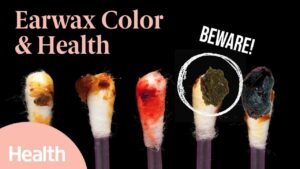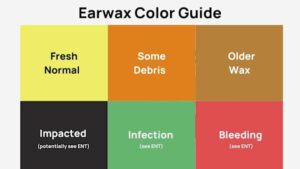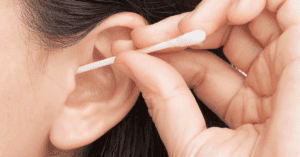What Your Earwax Color Reveals About Your Health – ENT Explains
-by ENT specialist doctor-Dr Sagar Rajkuwar, Nashik ,Maharashtra ,India -clinic website-
www.entspecialistinnashik.com
Table of contents-
- Introduction
- Earwax colors
- The consistency of earwax
- When should you see a doctor?
- Keeping the ears clean and healthy
- Summary
Introduction:
Although it might appear to be a little and insignificant component of our body, earwax can really tell us a lot about our ear health and general wellbeing. The quantity of earwax you make, as well as its color and texture, can tell you whether your ears are healthy, irritated, or suffering from an underlying ailment. Each kind of earwax, ranging from light yellow and soft to dark brown and sticky, has a meaning that medical professionals frequently employ as a hint when diagnosing ear issues. This essay will discuss the meaning of various earwax colors, when they are considered normal, and when they may be a warning that you should see an ENT professional.


The color of earwax can provide information about a person’s health; healthy earwax is generally sticky (wet type) and pale yellow to orange-brown or flaky (dry type) and off-white. Other hues might indicate problems: black or thick earwax may be impacted or caused by stress, gray earwax may be a sign of a dry skin condition or dust, and bloody or green earwax typically indicates an infection or injury that needs medical attention. Dark brown earwax might indicate older wax.
What you should know about the hue of ear wax Although earwax, also known as cerumen, can have different colors, it is often amber-orange to light brown. Changes in the color of earwax can be a sign of a variety of conditions, including infection and injury.
Earwax is crucial for maintaining ear health. It aids in the removal of debris from the ear canal, stops foreign objects and particles from entering the ear, and even offers some defense against germs.
Discover the meaning behind the various hues and textures of earwax in this piece, as well as how to properly remove it from your ear.
Earwax that is typical
- Pale yellow to orange-brown: This indicates normal, healthy earwax.
- Color variation: The color of the wax varies with its age; newer wax is brighter, whereas older wax is darker.
- Wet and dry earwax are caused by genetics, with wet earwax being the dominant type and dry earwax being the recessive type.
Earwax colors
Unusual Earwax Colors and Signs


- Dark brown or black: This may suggest impacted or older, accumulated earwax.
- Gray: Frequently due to a accumulation of dust or other debris, but if the wax is fragile, it may also indicate dry skin or a skin infection.
- Yellow or green: This could indicate a serious ear infection, possibly one that is caused by pus.
- Red or streaked with blood: This shows a scratch, wound, or possibly a ruptured eardrum, and it needs urgent medical care.
- White or flaky: A sudden shift to dry and flaky earwax might suggest a skin infection, even if some dry earwax is normal.
Earwax is typically moist, sticky, and ranges in color from amber-orange to light brown. Some people find it to be paler and drier, more like yellow or off-white.
The hue of earwax typically depends on its age. Older earwax tends to be darker in hue since it absorbs more dirt as it gets older.
The quantity, texture, and color of earwax differ widely from individual to individual. The ears of the majority of people who produce a typical quantity of earwax are able to eliminate it on their own. This occurs at different rates, which might result in earwax with various textures.
However, some people create more wax than usual. The ears may not be able to remove the wax quickly enough in this situation, which might result in obstructions. Even if someone produces a typical amount of ear wax, obstructions can still happen if their ear canal form is little or unusual.
The wax’s color and texture can be altered by obstructions in the ear. If the wax cannot be removed by the individual, the ear canal may get completely blocked, which could impair hearing.
Release
Ear discharge brought on by infections and injuries can be:
- drippy
- bad-smelling
- bloody
- green
The consistency of earwax
As earwax gets older, its texture changes. Age and genetics can also be factors. The earwax of youngsters is often softer and lighter in color, while that of adults is often darker and harder.
When should you see a doctor?
Although healthy ears produce earwax with a variety of colors and textures, there are still times when someone should seek medical attention. If there is any discharge from the ear that is not earwax, it might be an indication of an ear infection, so you should see a doctor.
If there is blood in the earwax, see a doctor. Anyone who is prone to earwax buildup should also see a doctor right away if they experience any symptoms of a blockage, such as muffled hearing.


Factors that may raise the likelihood of ear wax accumulation include:
- persistent ear infections
- old age
- a lot of hair in the ears
- ear canal distortion
These individuals run the chance of developing earwax buildup and blockages. If they have any symptoms, like muffled hearing, they should consult their doctor about how to properly remove the wax from their ears.
If any patient has any ENT -Ear nose throat problems and requires any , consultation ,online consultation ,or surgery in clinic of ENT specialist Doctor Dr Sagar Rajkuwar ,he may TAKE APPOINTMENT BY CLICKING ON THE LINK GIVEN BELOW-
Clinic address of ENT SPECIALIST doctor Dr Sagar Rajkuwar-
Prabha ENT clinic, plot no 345,Saigram colony, opposite Indoline furniture Ambad link road ,Ambad ,1 km from Pathardi phata Nashik ,422010 ,Maharashtra, India-Dr Sagar Rajkuwar (MS-ENT), Cel no- 7387590194 , 9892596635
When Should You Visit a Doctor?
- If you see any abnormal earwax, see a doctor or an ENT expert:
- Bloody or extremely dark earwax.
- Earwax that is discolored (green or yellow) or smelly.
- Any alteration in hue or consistency that is accompanied by pain, hearing loss, or a sense of fullness.
Keeping the ears clean and healthy
To maintain healthy ears, the easiest rule is to just leave them alone. Avoid putting anything into the ear canal in an attempt to get rid of earwax, such as cotton buds, fingers, or any sharp item or equipment.
Anything put into the ear canal only raises the chance of pushing wax further into the ear, where it can become trapped and create obstructions.
At home


Wash the outer ears gently with water and soap to clean them safely. Allow this to rinse into the ear canal to remove any wax that may have fallen from the walls of the canal. Because this wax has completed its purpose, it is now safe to rinse it off.
Use a towel to remove any extra wax or moisture from the outside. This is all the cleaning that the majority of people’s ears require.
The only safe way to aid wax in leaving the ear canal at home if the ears generate excessive wax is by using earwax thinning drops. However, ear drops should only ever be used if the eardrums are completely intact and there are no perforations or ear tubes.
Procedures


If impacted ear wax is causing negative symptoms or preventing a physical exam, doctors may prescribe Trusted Source an ear irrigation treatment. Microsuction, or removal using specific tools, may also be a suitable treatment option.
Summary
The color and consistency of earwax can change significantly depending on its health. The ears are self-cleaning, and it’s usually best to just leave them alone.
Too much wax, though, can accumulate deep within the ear canal and create a barrier. This could result in some hearing loss and increase a person’s risk of other health issues.
Consult a doctor for particular advice if you have earwax blockages or think you create too much wax.
References-
This article is written as per the clinical experience of ENT Specialist doctor -Dr Sagar Rajkuwar(MS-ENT) ,Nashik Maharashtra -Clinic website-www.entspecialistinnashik.com References taken from-
https://www.medicalnewstoday.com/articles/326093
For link on you tube video on -What Your Earwax Color Says About Your Health please click on the link given below-




